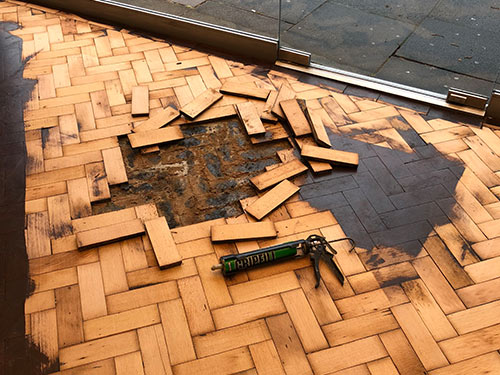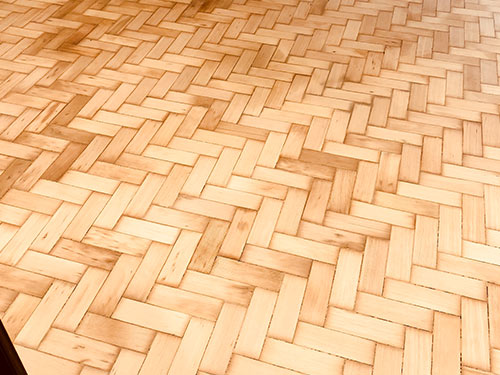Back to Parquet Restoration
Fixing Loose Parquet Flooring: Easy DIY Repair Guide
 Parquet flooring is known for its timeless beauty and intricate design — but over time, individual blocks can become loose or damaged due to age, moisture, or subfloor issues. When this happens, it doesn’t mean your floor is beyond saving. In many cases, you can repair loose parquet blocks yourself with a few tools and a bit of patience.
Parquet flooring is known for its timeless beauty and intricate design — but over time, individual blocks can become loose or damaged due to age, moisture, or subfloor issues. When this happens, it doesn’t mean your floor is beyond saving. In many cases, you can repair loose parquet blocks yourself with a few tools and a bit of patience.
In this guide, we’ll walk you through a step-by-step DIY process to fix common parquet issues. Whether you’re dealing with a single block that’s popped up or a small patch of loosened tiles, the methods below can help you restore your floor’s integrity and appearance. We’ll also highlight when it’s best to call in the pros, like our team at FlooringFirst! Parquet Repair Services.
Ready to get started? Let’s look at what causes parquet blocks to come loose in the first place.
Common Causes of Loose or Damaged Parquet Blocks
Before starting any repairs, it’s helpful to understand why your parquet flooring has become loose or damaged. Identifying the root cause can help you avoid future issues and ensure your fix lasts.
- Moisture Exposure: One of the most common culprits. Water leaks, spills, or excessive humidity can weaken the adhesive beneath the blocks, causing them to lift or warp.
- Old or Failed Adhesive: Over time, traditional bitumen or older adhesives can dry out, lose their grip, or become brittle, especially in older homes.
- Subfloor Movement: Shifts in the subfloor due to temperature changes or foundation settling can disrupt the stability of parquet tiles.
- Heavy Foot Traffic or Furniture: Repeated pressure or dragging furniture can loosen individual blocks over the years, especially in high-use areas like hallways or living rooms.
Once you’ve identified the likely cause, you can take the right steps to fix the issue and prevent further damage. If moisture is the root cause, consider checking our guide on repairing water-damaged wood floors.
Tools and Materials You’ll Need
Before getting started with your parquet block repair, make sure you have the following tools and supplies ready. Having everything on hand will make the process smoother and help you achieve a professional-looking result.
- Wood adhesive – Choose a suitable adhesive based on your subfloor type (e.g. flexible parquet adhesive for wood or concrete)
- Chisel or utility knife – For carefully lifting loose blocks without damaging neighbouring pieces
- Rubber mallet – To tap the parquet block back into place gently
- Sandpaper or sanding block – For smoothing edges or blending the repaired area
- Vacuum or brush – To clean dust and debris from the subfloor
- Weights or heavy books – To press the repaired block firmly in place while the adhesive cures
- Wood filler or resin – Optional, for filling small gaps between blocks
- Wood stain or finish – If the repaired block needs to be colour-matched to the rest of the floor
Once you’re fully equipped, you can move on to the actual repair — let’s walk through it step by step.
Step-by-Step Guide to Repairing Parquet Blocks
Follow these steps to securely refit loose or damaged parquet blocks and restore the integrity of your floor. This method works for most small-scale repairs and is ideal for DIYers comfortable with light carpentry.
- Remove the loose or damaged block
Carefully lift the affected parquet block using a chisel or utility knife. If it's stuck, gently tap the chisel to loosen it. Avoid damaging surrounding blocks.
- Clean the area thoroughly
Remove any old adhesive, dust, or debris from both the block and the subfloor using a scraper and vacuum. A clean surface ensures better adhesion.
- Apply adhesive
Spread a thin, even layer of wood adhesive on the subfloor using a notched trowel. Be sure to follow the manufacturer’s recommendations for drying time and coverage.
- Refit the parquet block
Press the block firmly into place, aligning it carefully with adjacent tiles. Use a rubber mallet to gently tap it flush with the surrounding surface.
- Weigh it down
Place a heavy object, such as a stack of books or a weight, over the block to ensure a strong bond. Leave it for the recommended curing time (typically 12–24 hours).
Need help matching older parquet blocks or sourcing replacements? Explore our parquet floor repair services in London — we can help you restore historic or hard-to-find block styles with precision.
Finishing Touches
 Once the adhesive has cured and the parquet block is securely in place, it’s time to refine the surface and ensure the repair blends in seamlessly with the rest of the floor.
Once the adhesive has cured and the parquet block is securely in place, it’s time to refine the surface and ensure the repair blends in seamlessly with the rest of the floor.
- Light sanding: Use a sanding block or fine-grit sandpaper to gently smooth the surface of the newly fixed block. This helps level out any minor height differences and prepares it for finishing.
- Colour matching (if needed): If the repaired block differs in tone, apply a matching wood stain or colour matching solution to help it blend with the surrounding area. Always test the colour on an offcut or hidden spot first.
- Sealing: Finish the surface with a compatible finish — such as oil, wax, or lacquer — to protect the wood and maintain consistency across the floor. You can read more about finishing options in our Ultimate Guide to Wood Floor Finishes.
- Gap filling: If any small gaps remain, especially after refitting multiple blocks, consider using a resin and sawdust mix or wood slivers for a tidy result.
After the finishing is complete, allow time for the sealant to cure fully before returning rugs or furniture to the space.
When to Call a Professional
While DIY parquet repairs can be satisfying and cost-effective for minor fixes, some situations require expert attention to ensure long-lasting results and preserve the floor’s value.
Consider hiring a professional if:
- The damage spans a large area or affects a pattern like herringbone or chevron
- The subfloor is unstable, damp, or damaged and may need levelling or treatment
- You’re working with antique or heritage parquet blocks
- Multiple blocks are lifting due to adhesive failure or moisture problems
In these cases, our team at FlooringFirst! offers expert parquet floor repair and restoration services across London. We use professional-grade adhesives, dust-free sanding equipment, and colour-matching finishes to bring your parquet floor back to life — quickly and with minimal disruption.
Conclusion: Restore Your Parquet Floor with Confidence
Repairing loose or damaged parquet blocks is a practical way to extend the life of your flooring and maintain its classic beauty. With the right tools, preparation, and care, even homeowners can fix small areas and enjoy great results. However, when the damage is more complex or widespread, it’s best to bring in professionals who can ensure a flawless, long-lasting finish.
Need help restoring your parquet floor? Contact FlooringFirst! for expert parquet floor repairs in London. We also offer parquet floor sanding, colour matching, and gap filling services to complete the perfect restoration.
Want to explore more parquet care tips? Check out our Parquet Restoration Guide for in-depth articles, expert advice, and inspiration for your next flooring project.